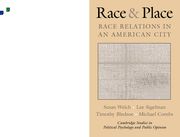Book contents
- Frontmatter
- Contents
- List of Figures
- List of Tables
- Preface
- 1 Introduction
- 2 Race Relations in Detroit, 1968–1992
- 3 Black–White Social Interaction
- 4 Perceptions of Racial Discrimination
- 5 Black Racial Solidarity
- 6 White Racial Prejudice
- 7 Opinions on Urban Issues: The Schools and the Police
- 8 Conclusions
- Appendix A The Detroit Surveys
- Appendix B Detroit Survey Items and Measures
- References
- Author Index
- Subject Index
- Miscellaneous Endmatter
2 - Race Relations in Detroit, 1968–1992
Published online by Cambridge University Press: 05 June 2012
- Frontmatter
- Contents
- List of Figures
- List of Tables
- Preface
- 1 Introduction
- 2 Race Relations in Detroit, 1968–1992
- 3 Black–White Social Interaction
- 4 Perceptions of Racial Discrimination
- 5 Black Racial Solidarity
- 6 White Racial Prejudice
- 7 Opinions on Urban Issues: The Schools and the Police
- 8 Conclusions
- Appendix A The Detroit Surveys
- Appendix B Detroit Survey Items and Measures
- References
- Author Index
- Subject Index
- Miscellaneous Endmatter
Summary
“All of America's major cities are on greased skids,” one urban analyst has said. “What differentiates one from another is the angle of descent. You may slow the descent but unless there's a major shift in public policy, America will lose all its major cities” (quoted in Russakoff, 1994: 9). Once the industrial heart of the nation, Detroit is a city whose angle of descent has been steep, and whose probability of loss remains great. In this chapter we review that angle of descent in light of historical national patterns of residential segregation.
RACE IN DETROIT
In 1990, Detroit had 777,000 African American residents, more than any other city except New York and Chicago (O'Hare and Frey, 1992). It had the highest proportion of blacks of any major American city, with Atlanta, Washington, and New Orleans lagging considerably behind. It was also one of the most residentially segregated cities in the nation (Farley and Frey, 1994) and one where residential segregation had not significantly decreased, although it was not totally immune to the national trend toward declining segregation in the workplace and public facilities.
The population of Detroit peaked at approximately 2½ million residents in the mid-1950s, a decade when the auto industry boomed. By 1990, Detroit's population was less than 1 million, whereas its suburbs had swollen to 3 million people as a result of the tidal wave of whites that washed to the suburbs during the 1960s and 1970s.
- Type
- Chapter
- Information
- Race and PlaceRace Relations in an American City, pp. 19 - 46Publisher: Cambridge University PressPrint publication year: 2001



